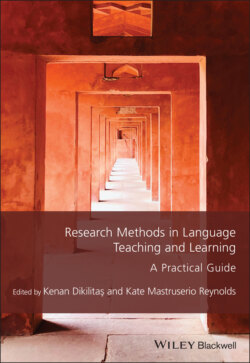Читать книгу Research Methods in Language Teaching and Learning - Группа авторов - Страница 30
Getting Started: Why Ethnography?
ОглавлениеAs I read more about “the social classroom” when planning my project, I was particularly drawn to the suggestion that learners’ interpretations of what lessons “are about” often differ from what a teacher intends, and that learners themselves often vary in their understandings of what happens in a lesson and in the language they notice and learn in a class (e.g., Allwright, 1984; Block, 1996; Tudor, 2001). Block (1996), for example, refers to a “gap” between a teacher’s and learners’ perceptions of particular classroom events, with implications for the effectiveness or otherwise of lessons and for learning. Such a “gap” seemed to offer a possible explanation for the types of questions I had about my own teaching (see Introduction).
Consequently, I narrowed the focus of my investigation from the very broad “examining the social construction of a language classroom” to uncovering the ways in which a particular teacher and class of learners perceived and ascribed significance to what happened in their language classroom. As such, I hoped to develop a genuine understanding of how the classroom was socially constructed by establishing, comparing, and contrasting the perspectives of the teacher and learners themselves. Such research would need to be contextual, unobtrusive, longitudinal, collaborative, interpretive, and organic (Nunan, 1992), and I, as the researcher, would aim not to intervene in or control naturally occurring events in the research setting. By trying to understand the classroom from the participants’ own perspectives in this way, I would, in effect, be engaging in ethnography.
Popular across many social sciences (e.g. anthropology, sociology), ethnography is an interpretive approach to research, which aims to “provide a longitudinal (long-term), in-depth understanding of the beliefs and practices of a group of people” (Avineri, 2017, p. 123). It seeks to unpack and question what is familiar, making it “strange,” while at the same time understanding what initially seems strange, thereby making it “familiar” (Kaplan-Weinger & Ullman, 2015). For example, in some language classrooms, learners are comfortable and even expect to work in pairs and small groups, but why is this – what beliefs and social and cultural norms inform this practice? Yet in other language classrooms, pair and group-work are difficult to establish, learners and teachers working and organizing tasks and activities in alternative ways. Again, why is this? (In this example, differences between classes are not necessarily between those in very different cultural contexts around the world; even classes in the same institution can differ significantly.) Ethnography thus seeks to “enquire about the hows and whys behind the whats that we see in particular cultures, doing our best to remain as objective and curious as possible” (Avineri, 2017, pp. 123–124, original emphasis). Consequently, the researcher aims to understand on its own terms the group being researched, which, in my study, was a specific class of learners and their teacher.
Thus, as Atkinson and Hammersley (1994, p. 248) note, in practice, ethnography emphasizes exploring social phenomena (e.g., a classroom) rather than setting out to test hypotheses. It tends to work with unstructured data, that is, data which is not assigned to a set of closed a priori categories when collected, instead allowing for key themes and topics to emerge from the data. Ethnography investigates a small number of cases, often just one, in detail. And it analyses human actions and activities through verbal and written descriptions and explanations, “with quantification and statistical analysis playing a subordinate role at most” (ibid., p. 248). Ethnography is thus an approach to research that was well suited to my research goals of exploring a specific language classroom as a social environment, one in which participants behaved and interacted with each other, and understood classroom learning and teaching, in ways that made sense to them.
